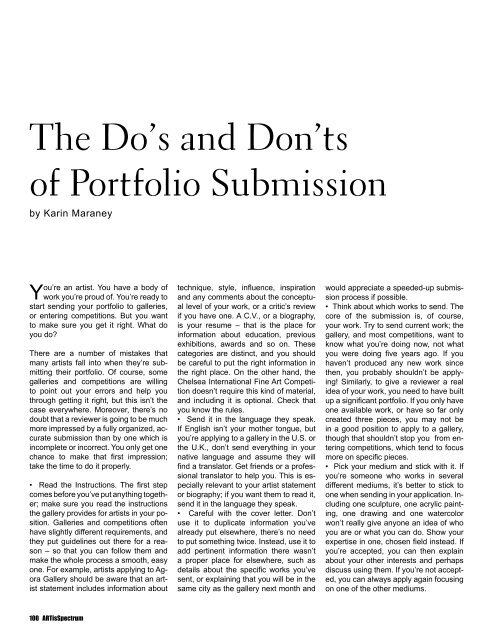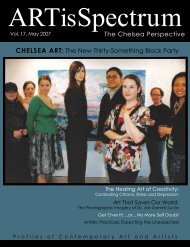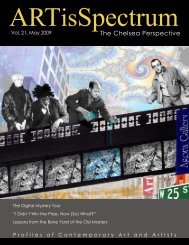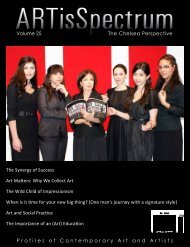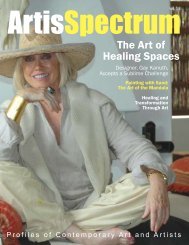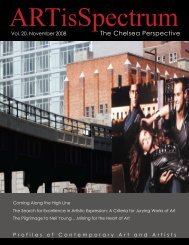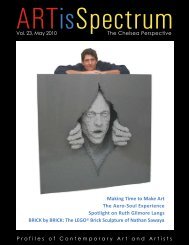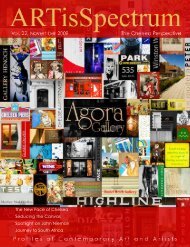Download PDF - ARTisSpectrum
Download PDF - ARTisSpectrum
Download PDF - ARTisSpectrum
- No tags were found...
You also want an ePaper? Increase the reach of your titles
YUMPU automatically turns print PDFs into web optimized ePapers that Google loves.
The Do’s and Don’tsof Portfolio Submissionby Karin MaraneyYou’re an artist. You have a body ofwork you’re proud of. You’re ready tostart sending your portfolio to galleries,or entering competitions. But you wantto make sure you get it right. What doyou do?There are a number of mistakes thatmany artists fall into when they’re submittingtheir portfolio. Of course, somegalleries and competitions are willingto point out your errors and help youthrough getting it right, but this isn’t thecase everywhere. Moreover, there’s nodoubt that a reviewer is going to be muchmore impressed by a fully organized, accuratesubmission than by one which isincomplete or incorrect. You only get onechance to make that first impression;take the time to do it properly.• Read the Instructions. The first stepcomes before you’ve put anything together;make sure you read the instructionsthe gallery provides for artists in your position.Galleries and competitions oftenhave slightly different requirements, andthey put guidelines out there for a reason– so that you can follow them andmake the whole process a smooth, easyone. For example, artists applying to AgoraGallery should be aware that an artiststatement includes information abouttechnique, style, influence, inspirationand any comments about the conceptuallevel of your work, or a critic’s reviewif you have one. A C.V., or a biography,is your resume – that is the place forinformation about education, previousexhibitions, awards and so on. Thesecategories are distinct, and you shouldbe careful to put the right information inthe right place. On the other hand, theChelsea International Fine Art Competitiondoesn’t require this kind of material,and including it is optional. Check thatyou know the rules.• Send it in the language they speak.If English isn’t your mother tongue, butyou’re applying to a gallery in the U.S. orthe U.K., don’t send everything in yournative language and assume they willfind a translator. Get friends or a professionaltranslator to help you. This is especiallyrelevant to your artist statementor biography; if you want them to read it,send it in the language they speak.• Careful with the cover letter. Don’tuse it to duplicate information you’vealready put elsewhere, there’s no needto put something twice. Instead, use it toadd pertinent information there wasn’ta proper place for elsewhere, such asdetails about the specific works you’vesent, or explaining that you will be in thesame city as the gallery next month andwould appreciate a speeded-up submissionprocess if possible.• Think about which works to send. Thecore of the submission is, of course,your work. Try to send current work; thegallery, and most competitions, want toknow what you’re doing now, not whatyou were doing five years ago. If youhaven’t produced any new work sincethen, you probably shouldn’t be applying!Similarly, to give a reviewer a realidea of your work, you need to have builtup a significant portfolio. If you only haveone available work, or have so far onlycreated three pieces, you may not bein a good position to apply to a gallery,though that shouldn’t stop you from enteringcompetitions, which tend to focusmore on specific pieces.• Pick your medium and stick with it. Ifyou’re someone who works in severaldifferent mediums, it’s better to stick toone when sending in your application. Includingone sculpture, one acrylic painting,one drawing and one watercolorwon’t really give anyone an idea of whoyou are or what you can do. Show yourexpertise in one, chosen field instead. Ifyou’re accepted, you can then explainabout your other interests and perhapsdiscuss using them. If you’re not accepted,you can always apply again focusingon one of the other mediums.100 <strong>ARTisSpectrum</strong>


